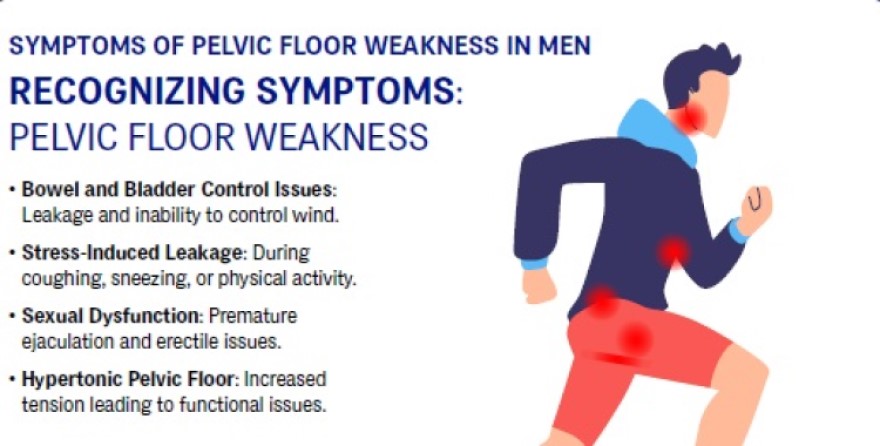Active living
Kegel Exercises For Men: How To Strengthen Your Bladder
Male urinary incontinence can be a daunting subject for most men, especially after prostate surgery, but there is no need to be embarrassed, and healthcare professionals are always on hand to offer a guiding hand with these issues. The condition is both preventable and manageable with bladder exercises – better known as Kegel exercises for men – which can help you take back control of your leaky bladder.
Terms like pelvic floor exercises for men and male bladder exercises are becoming more prominent as many men find themselves too embarrassed to discuss a leaky bladder with their loved ones or even their physician. Kegel exercises are simple clench-and-release exercises that strengthen your pelvic floor muscles. They can support your bladder and bowel function. You can train your pelvic floor muscles like you can train any other muscle. These can be done by both men and women to improve or eliminate bladder or bowel leakage.
The positive news is: male pelvic floor exercises hardly take up five minutes of your time, and can help you dramatically improve your pelvic floor muscles in order to control and manage urinary leakage.
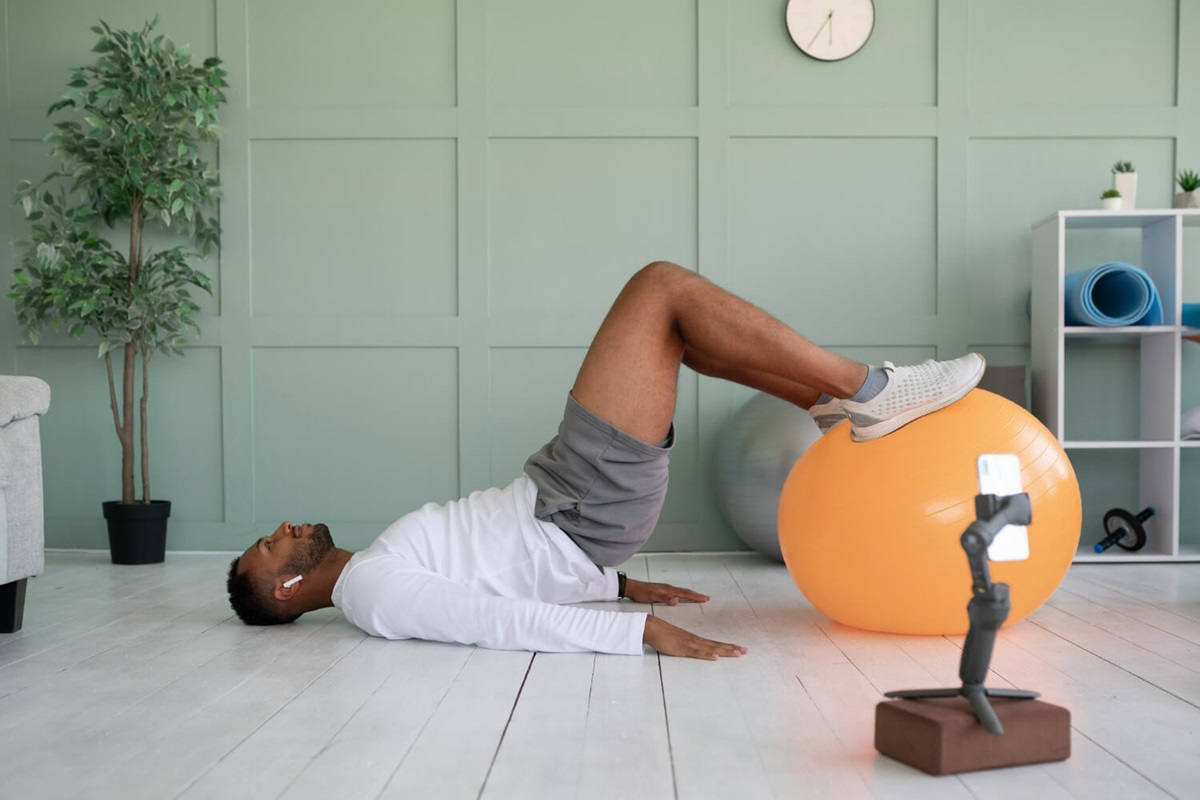
The pelvic floor muscles are located below the bladder and help you control urination. When you feel the urge to urinate and have to ‘hold it in’ for a while due to not having immediate access to a toilet, it’s these muscles that you are using to prevent urine from leaking. Exercises like ‘Kegels’ help you target these muscles directly.
Urinary incontinence in men can also be caused by a weak urinary sphincter due to prostate cancer surgery, an injury to the area, or an overactive bladder. Kegel exercises are a great way to not only improve but also, in some cases, fully restore normal bladder function.
In addition, continence products for men can also help tremendously.
How To Locate Pelvic Floor Muscles
Once you understand how to target the right muscles, pelvic floor exercises for men like Kegels are really easy. You can locate your pelvic floor muscles while urinating:
-
Halfway through peeing, simply slow down the urine flow.
-
Try not to tense up the muscles in your abdomen, legs, or buttocks. Don’t hold your breath either.
-
When you are able to slow down or stop the urine flow, you’ve successfully located the target muscles!
How To Perform Kegel Exercises
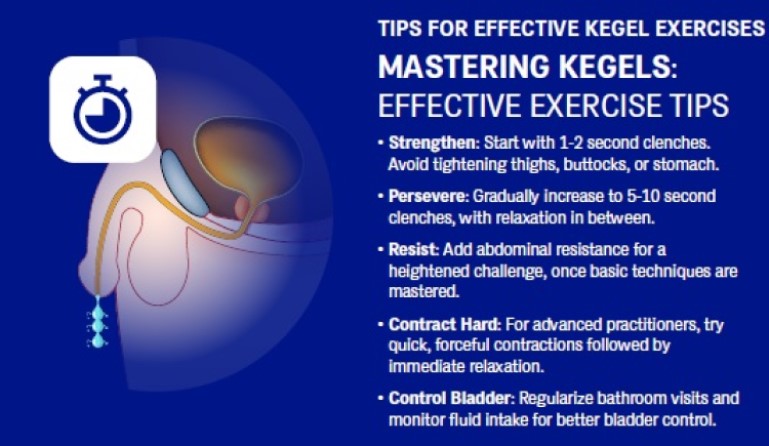
Wondering how to do Kegels for men? It’s really simple, especially as you get into the habit of practicing them regularly:
- Strengthen
Clench and hold your pelvic floor muscles for at least 1-2 seconds. Relax for 10 seconds and repeat. Do this ten times or ten repetitions. Do not tighten your thighs, buttocks or stomach while doing Kegels.
- Persevere
Use the same principle from above, but this time repeat each clench for up to 5-10 seconds, slowly building up to 10 repetitions for each set. Relax your pelvic floor muscles for 20 seconds between repetitions.
- Resist
Want to make Kegels more challenging? Add a little bit of abdominal resistance while you focus on the strength and persevere phase. We initially recommended against adding abdominal tension but that was only because we need to find the target muscles first before adding any kind of additional tension!
- Contract hard
If you’ve mastered all the three stages above, try hard and fast contractions where you execute each repetition with as much force and power as you can, and then relax the muscles immediately instead of counting slowly to 10, for example. Repeat this up to ten times.
Control bladder
A great way to further improve the pelvic floor muscles is by scheduling your bathroom visits at the same time every day and tracking how much water/fluids you drink each day. For instance, if you’re drinking up to 1.5-2 litres a day, it’s perfectly normal to make ‘pitstops’ at the bathroom 8 times a day. But if you’re urinating more frequently, do Kegels to have better control of your bladder.
Many people just starting out with Kegel exercises find it easier to do them while lying down, as your muscles won’t be fighting gravity. Also, you may want to initially contract and release your muscles for two to three seconds, just to get a feel for it. If you find that too easy or not challenging enough, then start with a five-second count instead.
However, after a few weeks, you should start challenging yourself more, and that means contracting your muscles for a slow count of up to five to ten seconds. To make it more challenging, carry out your exercises while standing up, as this puts more weight on the target muscles, or, in other words, they’ll be fighting gravity, hence improving bladder control even more over time.
Benefits Of Kegel Exercises For Men
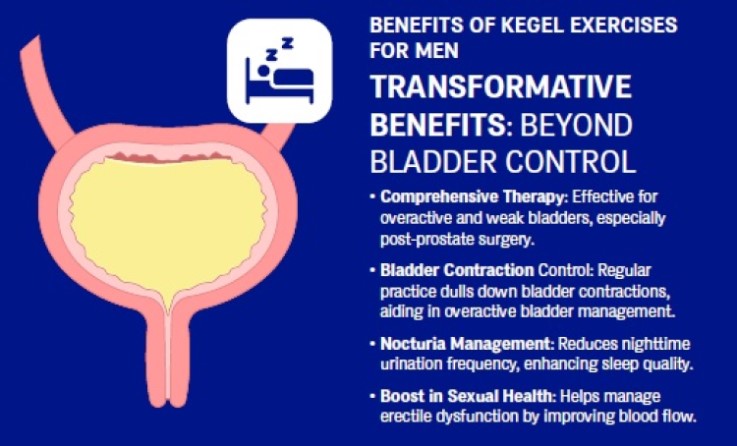
Pelvic floor exercises are a tried-and-tested therapy for men who have an overactive bladder, a weak bladder, and for men who suffer from urinary incontinence due to prostate surgery.
By repeatedly clenching and ‘training’ the pelvic floor muscles, you can suppress and dull down bladder contractions therefore helping to manage an overactive bladder.
Kegel exercises can help treat nocturia (night-time incontinence), thus reducing the urge to urinate multiple times during the night, which can improve the quality of your sleep.
These exercises can also help in the management of erectile dysfunction, a condition that’s becoming more common, even among young and healthy adult males. Strong pelvic floor muscles facilitate better blood flow to the groin, thus improving sexual functioning.
Dealing with conditions like erectile dysfunction can be psychologically debilitating. Here are some health tips for men to help you feel at your best.
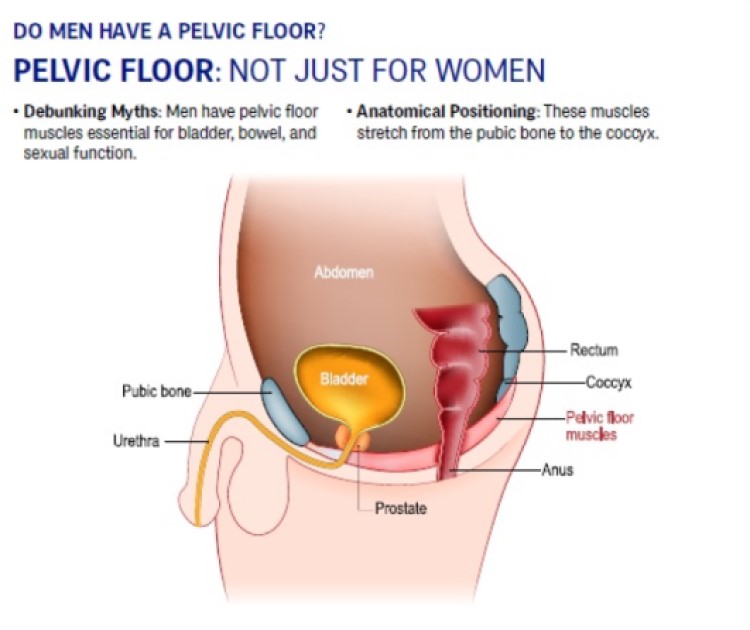
A common misconception is that only women have a pelvic floor; this isn’t true. Men have pelvic floor muscles, too, and when these are not functioning as intended, it can cause problems with the bladder and bowel and even sexual dysfunction.
For reference, the male pelvic floor muscles are situated right at the base of the pelvis, running across from the pubic bone at the front to the tailbone, known as the coccyx, at the back.
Causes Of Pelvic Floor Weakness Or Dysfunction In Men
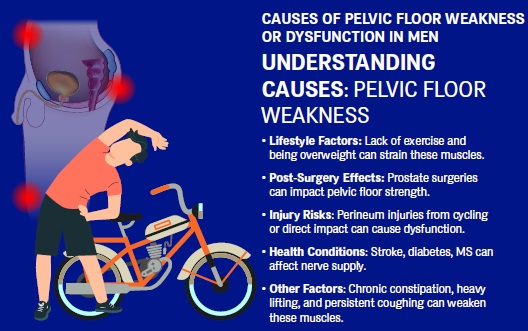
The pelvic floor muscles can become weak or dysfunctional due to several reasons, including:
A lack of regular exercise or poor levels of physical activity and fitness, including being obese or overweight, can all contribute to poor muscle tone in the body, hence increasing the strain on the pelvic floor muscles.
- Incontinence after prostate surgery, a prostatectomy, or transurethral resection of the prostate (TURP) can adversely affect the pelvic floor and its accompanying nerve supply. Pelvic radiation can also affect the pelvic floor.
Injury to the perineum (the area between the base of the penis and the anus) through a direct blow or prolonged pressure, such as long-term catheter use, sitting on a bicycle or motorbike for extended durations.
Specific health conditions like stroke, diabetes, and multiple sclerosis (MS) can affect the nerve supply to the pelvic floor muscles.
Persistent or chronic constipation, frequent heavy lifting, or chronic coughing can all stretch the pelvic floor muscles, affecting their nerve supply and that of the adjoining tissues. This can cause bladder problems in men.
Bowel leakage is the accidental leakage of faeces or not being able to control wind.
Stress urinary leakage during activities like lounging, sneezing, coughing or challenging physical activity, including sports.
Premature ejaculation during sexual activity, or ejaculating sooner than you or your partner would like.
Erectile dysfunction, i.e. not being able to gain or sustain an erection.
Hypertonic pelvic floor is a condition where the increased muscle tension in the lower pelvic muscles prevent them from relaxing and coordinating the control of multiple bodily functions.
When To Expect Results From Doing Kegels

Bladder exercises like Kegels are a form of ‘exercise’, after all, which means progress cannot be made overnight.
So, for example, if you’re practicing your Kegels three times a day, you should experience improved bladder control in three to six weeks. Some men, in fact, may see results sooner. It’s always a good idea to note down your urine leakage with each passing day to measure the improvements you’ve made.
If you don’t notice any significant improvement in a month or so, then you have likely not been targeting the right muscles. At this point, it may help to get in touch with a healthcare professional for advice, who may refer you to a physiotherapist.
Five Tips To Make Kegel A Habit

As with any kind of exercise, the key to achieving success is making the exercises a habit.
- Practice consistency: Engage in Kegel exercises at the same time each day so that your muscles get used to the stimulus and get stronger over time. Increase the intensity slightly over time, as we discussed earlier. Building the exercises into your morning routine is a good starting point. For example, you could practice Kegels while waiting for the kettle to boil or brushing your teeth.
- Reflect on the benefits regularly: By keeping up with Kegels daily, you will eventually start to see a positive change in your urinary continence.
Measure progress over time: With time, you will find that your urinary incontinence is improving and becoming more manageable. In fact, you may even be able to enjoy sports sooner than you think! You’ll also experience fewer leaks and become better at controlling your bladder
Consider pads for men: Dealing with incontinence can be embarrassing, especially when you’re out and about. While Kegels will help you regain your confidence, pads specifically designed for men (Leakage Control Never Felt So Good | Molicare – HARTMANN Direct) can also help prevent any embarrassing moments while you’re still mastering Kegels to have better control of your pelvic floor.
Write it down: Keep a note in a diary to measure the progress of the exercises; this will also be useful when revisiting your doctor to check on your progress, too.
Strengthen Bladder Muscles
The next time you wonder how to strengthen your bladder or somebody asks the same, you can immediately dive into the importance of how to do Kegels and educate them on pelvic floor exercises for men!
So, stay consistent and regular with your Kegels. Make them more challenging over time and increase or reduce the frequency depending on how much bladder control you want. Most importantly, be patient, as optimal results may take a few months.
How can a man strengthen his bladder?
A man can strengthen his bladder by performing pelvic floor exercises (Kegels), which involve repeatedly contracting and relaxing the muscles used to stop urine flow. Other methods include bladder training, managing fluid intake, and maintaining a healthy weight.
What is the 5 second exercise for the prostate?
The 5 second exercise for the prostate is a form of Kegel exercise where a man contracts his pelvic floor muscles for five seconds, then relaxes them for five seconds. This is typically repeated 10 times in a session, done three times a day.
What exercises can I do to strengthen my bladder?
To strengthen the bladder, you can do pelvic floor exercises (Kegels), which involve tightening and holding the muscles used to control urination. Bladder training exercises, such as delaying urination and scheduled bathroom visits, can also be beneficial.
Do bladder exercises work?
Yes, bladder exercises, particularly pelvic floor muscle exercises (Kegels), are effective in strengthening the bladder and improving bladder control. Consistency and correct technique are key for seeing results.
Kegel exercises for men: Strengthen your bladder
- Sources
- What are kegel exercises for men?
- How to locate pelvic floor muscles
- How to perform kegel exercises
- Benefits of kegel exercises for men
- Do men have a pelvic floor
- Causes of pelvic floor weakness or dysfunction in men
- Symptoms of bladder floor weakness in men
- When to expect results from doing kegels
- 5 tips to make kegels a habit
- Strengthen bladder muscles
- FAQs
Sources
Lee, C., (2023) Why ALL men over 50 should practice pelvic floor exercises to help with issues from a leaky bladder to sex problems. Daily Mail. [online] Available at: https://www.dailymail.co.uk/health/article-12585681/Men-50-practise-pelvic-floor-exercises.html [accessed 24/01/24]

MoliCare Premium Form Bariatric
<h2>Optimum Wear Experience</h2> <p>Our selection of MoliCare® Premium Form + Size 8 drops provides the perfect solution as a high capacity pad to manage severe levels of incontinence in bariatric people in an easy and comfortable manner.</p> <p>Using this product alongside fixation pants allows for the skin to breathe and ensures optimum wearing comfort. These larger incontinence pads are ideal for those experiencing moderate to severe bladder or bowel weakness, catering to all wearers, whether active and independent or bedbound and dependent.</p> <h2>Body-shaped and disposable</h2> <p>Benefit from body-shaped, disposable incontinence pads designed to provide maximum leakage protection for both men and women. We recommend using these pads to deliver reliable and secure protection against leaks, keeping you confident and dry throughout the day. Maintain healthy skin with the skin-neutral value of pH 5.5 and an antibacterial finish. These pads are specially designed to let your skin breathe, ensuring comfort and well-being.</p> <p>Stay informed with the wetness indicator, showing when it is time to change the pad. The easy application and removal of this incontinence product are suitable for all wearers, whether standing or lying down.</p> <h2>Guaranteed Price Promise</h2> <p>With different absorbency levels available, MoliCare® incontinence products cater to all levels of incontinence, ensuring secure care and comfort.</p> <p>Embrace the convenience of MoliCare® Large Shaped Pads, providing you with the confidence to get on with your life without worries. Order online with our price match promise and discreet delivery, directly to your door, with free delivery on all orders over £40.</p> <p>For personalised information, our knowledgeable customer care team is ready to help. Call us today at 0800 028 9470 and experience the comfort and reliability of MoliCare® Premium Form + Size 8 Drops.</p>
MoliCare Rectangular 3.5 Drops
<h2>Manage Incontinence</h2> <p>Choose MoliCare® for added protection based on your toiletry needs. Embrace the freedom and confidence that MoliCare® Rectangular Pads bring to your life. Managing incontinence has never been this comfortable and discreet for men and women.</p> <p>The MoliCare® Rectangular Pads are designed to handle slight incontinence levels. These slim and lightweight absorbent incontinence pads offer discreet protection that fits seamlessly in your underwear.</p> <p>Stay worry-free with their shape, which remains barely noticeable under your clothes. The waterproof backing provides added protection, while the core padding swiftly draws away any moisture, keeping you and your skin fresh and dry.</p> <p>Securely fix the Rectangular pad in your everyday underwear or use it with fixation pants for extra reassurance. Rest assured that these pads will protect you and your clothes from any leaks or spills.</p> <h2>Lightweight protection</h2> <p>Experience discreet and lightweight protection for light incontinence, tailored to fit your needs perfectly. Our online order service is quick and convenient, offering discreet delivery right to your door. Enjoy FREE delivery on all orders over £40, making your experience even more convenient and cost-effective.</p> <p>If you need assistance in choosing the best incontinence products for your needs, don't hesitate to reach out to our knowledgeable customer service team. We're here to help and provide you with the support and advice you need. Give us a call today at 0800 028 9470, and take the first step toward a more confident and comfortable life with MoliCare® Rectangular 3.5 drops.</p>
MoliCare® Premium Elastic 8 Drops
<h3>Convenient and Comfortable MoliCare® Premium Elastic 8 Drops</h3> <p>Some of the key benefits of investing in our products include:</p> <ul> <li>Suitable for men and women of all age groups.</li> <li>Skin-neutral pH value of 5.5 in all products.</li> <li>Premium elastic prevents leakages and odours.</li> <li>Easy to determine when a change is required.</li> </ul> <h3>Stress-Free Incontinence Experiences</h3> <p>When it comes to managing incontinence, there is a wide range of products available to cater to different levels of need. Among these options are incontinence slips, which consist of a large absorbent slip supported by an attached fixation system, commonly known as adult nappies.</p> <p>Anti-Leakage Protection</p> <p>Living with incontinence means wearing an appropriate product throughout the day, with occasional changes. That's why selecting the right solution that guarantees comfort, mobility, and easy changeability is crucial. The MoliCare® Premium Elastic 8 Drops (ISO 2356) is an all-in-one premium disposable adult diaper featuring two elasticated side panels and two re-closable hook and loop tapes on each side. This product caters to a wide spectrum of incontinence levels, ranging from moderate to severe bladder weakness and/or faecal incontinence. By wearing these incontinence slips, instead of regular underwear, people will experience a reassuring, comfortable fit, thanks to the elasticated side panels. Whether the wearer is active and independent or bedbound and dependent, they can enjoy full mobility and comfort. Water repellent, anti-leakage cuffs means that urine can’t escape from the sides urine is directed inwards to the absorbent core where it can be safely stored.</p> <p><a href="https://www.hartmanndirect.co.uk/incontinence-products" style="color:#0563c1; text-decoration:underline">MoliCare® incontinence products</a> are available in different absorbency levels to cater for everyone with varying degrees of incontinence.</p> <p>HARTMANN Direct offers a fast, discreet delivery straight to your doorstep. Our products are developed with your convenience and comfort in mind, and we stand behind that quality with a price promise match. Additionally, orders exceeding £40 qualify for free delivery. If you require further assistance or guidance in selecting the right MoliCare® products, our friendly customer service team is just a phone call away. Choosing your Size</p> <p>Measure waist at the largest width between the waist and hips. Select the product size based on the below sizing.</p> <p>Small: 28-35 inches (70-90cm)</p> <p>Medium: 33-47 inches (85-120cm)</p> <p>Large: 45-57 inches (115-145cm)</p> <p>Extra Large: 55-69 inches (140-175cm)</p> <p>HARTMANN Direct offers a fast, discreet delivery straight to your doorstep. Our products are developed with your convenience and comfort in mind, and we stand behind that quality with a price promise match. Additionally, orders exceeding £40 qualify for free delivery. If you require further assistance or guidance in selecting the right MoliCare® products, our friendly customer service team is just a phone call away.</p>


